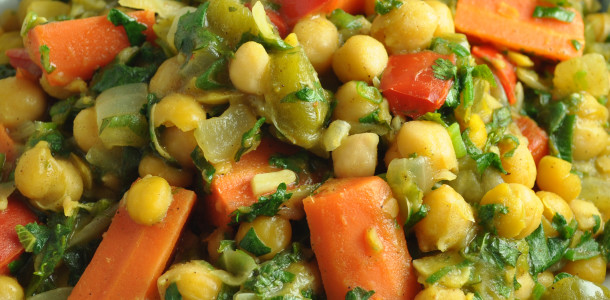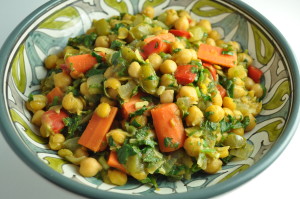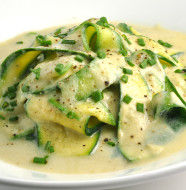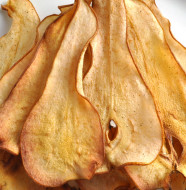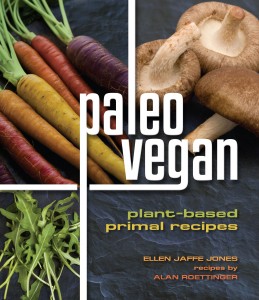Among the unexpected delights of having a career in food is the near-constant discovery of new foods and flavors. Even after more than thirty years, I still come across an unknown fruit, vegetable, grain, legume, herb, or spice from time to time. I’ve gone through periods where the pressure of work got the better of me, and I was more concerned with just getting through it than enjoying the process. At those times, I would rely on tried-and-true dishes that I could make blindfolded instead of taking adventurous detours. I knew where to go to get what I needed, and when I got there I was tunnel-visioned as I picked out my ingredients. Swept along in overwhelmed mode, I was disinclined to do much exploring. Eventually something would snap me out of the culinary doldrums and I would be back to my old self, starry-eyed in the markets, specialty shops and farmers’ markets. It has always been specifically that sense of wonder in the market that buoyed me up when I had become jaded and tired.
Every instance when I’ve happened upon a culinary treasure trove stands out unforgettably in my taste memory. I fondly remember a trip I took to Morocco back in 1973, when my parents thought I was in college. I grew up in Mexico, but I had never been anywhere so radically unfamiliar in my life. The land, the people, the architecture, the art, the customs, the music, everything about the place was exotic, including the food—especially the food. I loved to wander the outdoor market in Marrakech, where the unfamiliar reigned supreme. The ground spices, piled into tall, steep peaks, attracted and mystified me. They smelled heavenly, but I had no idea what they were, except that they were obviously the flavors of Morocco’s brilliant cuisine. For years afterward, I would have dreams about that astonishing land, its incredibly hospitable people, and their mesmerizing food.
Although it takes a lot of learning and practice to reproduce another people’s ethnic food, I’ve found that it’s possible to achieve a glimmer of similarity with just a few ingredients that are unique to it. To make this dish, I’ve borrowed two distinctly Moroccan ingredients: a spice mixture called ras el hanout, and preserved lemon. Ras el hanout means “top of the shop” in Arabic, indicating the shopkeeper’s signature blend. In Morocco, the specific mixture differs from shop to shop and may contain well over twenty ingredients, including some unexpected ones like cassia bark, lavender blossoms, orris root and rosebuds. Outside Morocco, most ras el hanout is commercially produced in France, and is fairly standardized. It has become widely available in recent years, in specialty shops and online. Preserved lemons are also gaining popularity, and they too are becoming easier to find. They’re also very easy to make*. Once you have these on hand—as well as a modest supply of saffron—you’re ready to branch out and try something extraordinary, like the modest example below.
Moroccan-flavored Garbanzos
Makes 4 servings
2 tablespoons extra-virgin olive oil
1 large white or yellow onion, cut into ½-inch dice
½ green bell pepper, cut into ½-inch dice
½ red bell pepper, cut into ½-inch dice
2 carrots, quartered lengthwise and cut into 1-inch lengths
7 cloves garlic, minced
3/4 teaspoon sea salt
4 cups cooked garbanzos, with cooking liquid
½ preserved lemon, cut into ¼-inch dice
2 teaspoons ras el hanout
Pinch saffron threads (optional, but come on—live a little!)
1 cup coarsely chopped cilantro
1 cup coarsely chopped mint
1 bunch thin scallions, very thinly sliced
Put the oil in a large pot over medium-high heat and add the onion. Cook, stirring frequently, until the onion just begins to color, about 5 minutes. Add the peppers and cook until they begin to soften, about 5 minutes. Add the carrots, garlic, and salt, and continue stirring until the garlic just begins to stick, another 3 to 4 minutes. Add the garbanzos with the cooking liquid, the preserved lemon, ras el hanout, and saffron, and stir well. Bring to a boil and then adjust the heat to maintain a simmer. Cover and cook, stirring often, until the vegetables are tender, about 20 minutes. If the mixture becomes a bit dry, add a little vegetable broth or water and swirl the pot or stir gently. Add the cilantro, mint and scallions, stirring gently to distribute evenly. Cook 1 more minute, and remove from the heat. Serve in bowls.
*Preserved lemons are among the everyday components of Moroccan food that make it starkly unique. I didn’t know it when I was there, because I was just eating and enjoying the various dishes, but preserved lemons are stars of that marvelous cuisine. Now, forty-two years later, they can be found in specialty shops and Middle Eastern markets, packed in small jars. But for a fraction of the cost, they can be easily made at home, as they are in homes all over Morocco. Their flavor is unparalleled, an amazing blend of sweet, sour, salty and bitter. Even one quarter of a preserved lemon, sliced or diced and added to a salad or stew, can alter the character of the dish dramatically. The brine itself can be used instead of salt, to impart flavor to salad dressings, sauces, and soups.
10 unblemished organic lemons, preferably Meyer lemons
Coarse salt, preferably Celtic salt
Wash the lemons well. Cut into the lemons as if to quarter them lengthwise, leaving the last 3/4-inch of them intact at the stem end. Spread a lemon open and pack about 1 tablespoon of the salt into the cuts. Repeat with the remaining lemons, using 1 tablespoon of salt for each one. Put the salted lemons in a sterilized 1-quart jar (see note), pressing down on them with a wooden spoon to squeeze the juice out and pack them in firmly. Be careful not to tear the skin.
The goal is to squeeze out enough juice to cover all the lemons, but this may not occur right away. Press down as much as possible without tearing the lemons, cover the jar, and leave in a cool, dark place overnight.
The next day, open the jar and press down on the lemons with a wooden spoon again, to encourage more juice to seep out. This time, more juice will run out, hopefully covering the lemons. Cover and return the jar to a cool, dark place, and leave overnight. Repeat on the third day, pressing down to extract more juice and compacting the lemons. If the lemon juice still doesn’t cover the lemons, add additional freshly squeezed lemon juice, as needed to fully submerge them. Once you’re confident that the lemons will remain submerged, cap the jar and return it to that cool, dark place and leave it alone for 1 month.
After 1 month, the lemons will be preserved, and you can begin using them. They will have become quite soft, with a silky, smooth texture. Store the jar in the refrigerator, where they will keep indefinitely.
Note: To sterilize the jar, wash and rinse thoroughly, then fill with boiling water. After a minute, empty the jar and allow it to air dry.
This post is an expanded and repurposed version of an article that first appeared in the July/August issue of Bella Spark Magazine.

